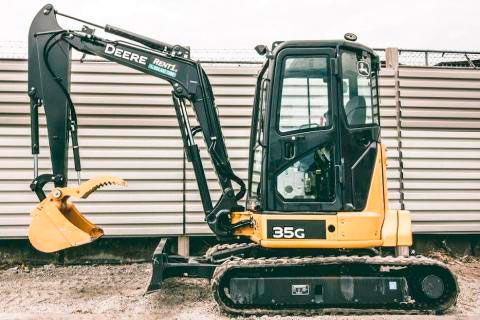How Wide is the 35 G & How to Fit it in Your Yard
Founded in Grand Detour, Illinois in 1837, John Deere is an American success story like few others. With its rich history of product development and innovation, the company has long been a valuable partner to those who cultivate, harvest, and build upon the land. Today, its machinery is a must-have across many industries: Lawn & garden, agriculture, construction, landscaping & grounds care, golf & sports turf, forestry, the military, and others. One of its most successful product lines are excavators, perhaps none more so than a model introduced in 2013 – the 35G compact excavator. Small, nimble, and easy to operate, it is invaluable for commercial and residential use.

Dimensions of the 35 G
According to John Deere, the 35G compact excavator is a mere 5 feet, 9 inches wide – puny compared to some full-size brutes known to tip the scales at more than 800 tons and a whopping 35 feet wide. But size is not everything, and the 35G more than makes up for stature in ease of use, affordability, and versatility.
If you are using a John Deere 35G compact excavator for landscaping or other residential work, then chances are you choose this model because of its relatively diminutive size when compared to other excavators. The Association of Equipment Manufacturers classifies excavators into three categories based on size:
- Mini or Compact is any machinery weighing up to 6 metric tons, roughly 13,227 pounds or less. The 35G appears to be a featherweight, tipping the scales at 3,520 pounds. These excavators are tailor-made for getting into tight spaces, ideal for your line of work or residential construction, utility work, and landscaping.
- Midi excavators are the middle brother and can weigh between 13,227 and 22,046 pounds. Larger, they are a familiar face on larger building construction sites, utilities, heavy road work, bridge construction, and landscaping.
- Standard/Full-Size Crawler Excavators tip the scales anywhere between 22,046 and 198,416 pounds. Yes, they are monsters, immensely capable of heavy lifting, digging, and related tasks.
And there is a fourth category that most consumers – and some working professionals – are not aware of: The heavy crawler excavator, classified as machines at 90 metric tons and greater.
How to Get the 35G into Your Yard
As a new product category, compact excavators debuted in the 1970s and are now the go-to machine for smaller jobs – think general landscaping, installing backyard water features, excavating for patios, retention walls, inground pools, or small structure demolition. In a word: Perfect. If you have a smallish job that requires more digging than you and a couple fellow weekend warriors can pull off in a day or two, welcome to the wonder that is the John Deere 35G.
Now that you have bought or rented a 35G and it is idling in your driveway, how do you get it in your backyard? There are essentially two options.
Your first is to drive the excavator into the yard through the gate. A single residential gate is normally up to 36 inches wide, so hopefully, you have access to a double wide gate, which could be up to 72 inches or six feet wide. Doing the math, you will notice there is not much room for error – a mere three inches, as the 35G, is 5 feet, 9 inches wide. Even more distressing is the fact your house or some other immovable structure may abut the fence line and gate area.
Onto the second option, which is labor-intensive, less desirable, and more likely to cause some grumbling between you and your work pals. We are talking about removing a portion of your fencing to get the John Deere 35G into your yard. To remove a section of a chain link fence, follow these steps:
- Look for the corner post closet to the gate. The chain link portion is attached to the post by a flat piece of metal called a tension bar.
- Loosen the clamp attached to the fence panel and tension bar. The clamp is held together by a bolt and screw, which you can loosen with a wrench.
- Once the clamp has been loosened, remove the tension bar, then slide it out of the weaved fence panel.
- Measure much of the fence fabric (it is actually metal) needs to be removed. If the 35G is nearly six feet wide, give it several inches of leeway on each side, if possible.
- Once you have decided how much of the fencing to remove, it can be rolled sideways out of the way along the portion of the fence that is still standing.
With adequate space, you can now drive the 35G through the opening in the fence and into your backyard. But the real fun is just beginning. Now, you can utilize the excavator to its fullest potential.
General Safety Tips
Even though the John Deere 35G is considered “compact,” it is still a large machine. At more than 3,000 pounds, it can do serious damage to people, pets, and property. Whether you are an experienced operator or using an excavator for the first time, you must be aware of what you are getting into. The following tips may be helpful.
- Does your property have below-ground utility lines? If you do not see any telephone or other utility poles, then the answer is probably yes. To be certain, put in a call to your local utility. Services are available that will locate and mark underground or hidden lines – gas, cable, water, or electric. This is a must-do.
- Refer to any product documentation about the maximum angle for slopes at which the 35G can safely operate.
- Make sure to avoid any previously excavated areas, such as a trench or an area that has been dug out for an in-ground swimming pool. These are easy to miss, especially on a sunny, cloudless day, or in a yard with lots of trees and shaded areas.
- Do not randomly drive the excavator around the yard if people or pets are present. You cannot assume that a bystander is aware of what you are doing, or that the machine may move around.
- If possible, drive in a straight line between two points.
- Are you going to be driving on grass? If so, consider placing heavy tarps or thin, wooden panels along the path. The 35G can be driven over them, without causing heavy damage to the lawn underneath its tracks.
- If someone is helping you with the work, decide who will operate the 35G and who will act as the spotter. Remember, the excavator cab accommodates one person – the driver. The mini excavator is built be driven by one person – do not use it to give someone a ride.
- Do not drive while distracted. Remember, a machinery of any kind should never be operated if you are impaired or injured, either temporarily or by permanent disability.
- If you are working in your yard, do you have to worry about low-hanging tree branches, overhead utilities, or nearby structures? Know where everything is located before driving away?
- Read the operator manual before starting the engine.
- If you have rented the excavator, make sure to follow any checklists provided by the rental company. You may be required to return the 35G only after topping off the fuel, oil, hydraulics, or cleaning the machine after use.
Controlling the 35G
Read the operator’s manual page by page, and practice using the machine before starting work. These two steps are essential to operating the John Deere 35G compact excavator as safely and efficiently as possible. There is any number of product tutorials and videos available from John Deere, so refer to them as much as possible.
The International Organization for Standardization has created standards for excavator controls, most of which have been adopted by equipment manufacturers worldwide. As you notice when perusing the operator’s manual, these are obvious and simple to understand: The left-hand joystick allows you to control the Swing to the left and right, and to move the Stick Boom closer and away from the machine. To control the Main Boom or to close and dump the Bucket, use the right-hand joystick for such maneuvers.
Be a Good Neighbor
Though the John Deere 35G compact excavator is smaller than other models, it is still loud when compared to other lawn equipment like mowers, leaf blowers, or weed whackers. As such, if your yard abuts someone else’s property, it would be helpful to let your neighbor know in advance the work you will be doing. Warn of loud noise and offer in advance to clean up any debris that makes it into their yard.
The 35G is versatile and immensely capable. Depending on the job requirements, it can be outfitted with dozens of accessories – hydraulic hammers, scrapers, brooms, specialized buckers, grapplers, planers, and many other attachments. Talk with a sales or rental professional for the best advice.
For more than 150 years, John Deere has been in the business of getting the job done, so you have made the right choice. Good luck.

